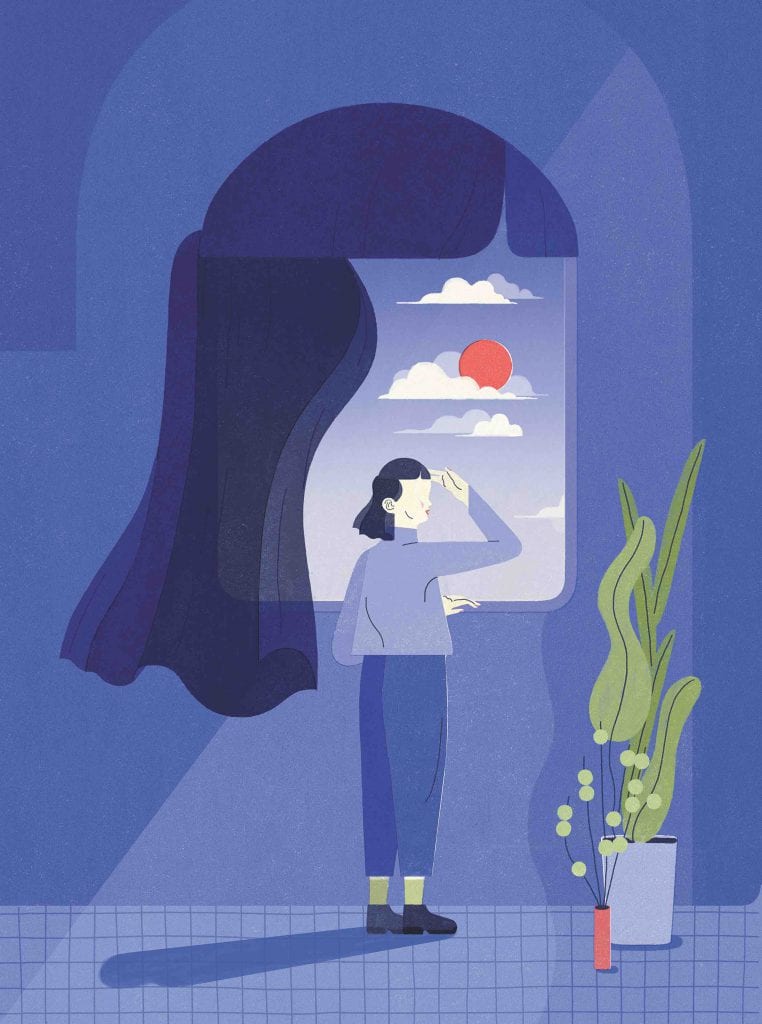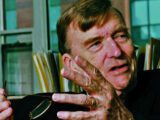I’m 10 years old, away at my first sleepover camp. The rest of the girls in my cabin are trying to put together a skit for the camp’s variety show, and I can see that it isn’t going to come together the way they imagine. I have a sixth sense about these things, like I’m on the outside looking in when I’m supposed to be part of something. I want to speak up and tell them how to fix it, but I’ve learned that being a know-it-all does not make me popular.
There is something about me that most people consider “different,” like that I don’t enjoy TV sitcoms in the same way as my peers or skip rope like other girls my age. I’m not comfortable hugging friends, but I do love listening to discussions about politics. I’m very talkative and inquisitive, which seems to wear out the patience of my friends and sometimes even the adults around me. My Grade 4 report outlined my social deficiencies with “needs improvement.” I stick out, but I’m learning to be less conspicuous. I feel lonely, but lonely is better than ridiculed.
You may unsubscribe from any of our newsletters at any time.
But it wasn’t until I turned 46 that I learned my uniqueness has a name: autism.
My diagnosis three years ago was like discovering a piece of my brain, picking it up, putting it in place and feeling whole for the first time. What I’ve found out since is that there are a significant number of others like me — individuals who weren’t identified as having autism until midlife. And for reasons that are still coming to light, many of them are women.
Given the profile autism has today, it’s surprising to learn that this common neurological condition was first written about in 1943. Simon Baron-Cohen, of the Autism Research Centre in Cambridge, U.K., outlines autism’s discovery in the British medical journal The Lancet: “Child psychiatrist Leo Kanner at Johns Hopkins University School of Medicine in Baltimore, MD, USA, wrote a seminal article in 1943 in which he described…11 children in his clinic without the social instinct to orient towards other people, who were mostly focused or even obsessed with objects, and who had a ‘need for sameness’ or a ‘resistance to (unexpected) change.’” Kanner named this disorder “infantile autism.” Only a year later, Austrian pediatrician Hans Asperger published a study about children in his clinic who exhibited similar characteristics. Though his work actually predates Kanner’s, his findings were largely overlooked until 1981. At that time, the term “Asperger’s syndrome” came to be applied to higher-functioning individuals — Asperger compared them to “absent–minded professors” who might be socially awkward but intellectually precocious. The line between autism and Asperger’s was erased in 2013 when the term “autism spectrum disorder” — ASD — was introduced.

Today, approximately one in 66 Canadian children is diagnosed on the autism spectrum, and according to experts those numbers are on the rise, possibly because of improved diagnostic methods and awareness of the condition. A neurodevelopmental disorder that affects brain development, autism can cause communication problems because of narrowed interests and a lack of awareness of social cues — for many who have it, social interactions have to be learned as opposed to intuited. However, Autism Canada notes, “Children and adults with ASDs usually have particular characteristics in common, but the conditions cover a wide spectrum, with individual differences in: number and particular kinds of symptoms; severity: mild to severe; age of onset; levels of functioning; challenges with social interactions.”
A widely used screening tool like the Adult Autism Spectrum Quotient (AQ) provides insight into the specific types of behaviour that can characterize autism. This self-reporting survey comprises 50 statements, such as “I would rather go to a library than a party,” “I am fascinated by numbers” and “I find it difficult to work out people’s intentions.” For me, looking at the Adult AQ is like reviewing a list of my own traits, skills and interests, in varying degrees. Some of my more prevalent characteristics are that I process information through thought rather than emotion, have a keen interest in how things work and have a surprising level of recall, as well as an ongoing internal dialogue.
Being autistic means I can appear dispassionate, even though I am empathetic. I am highly loyal, honest, straightforward and direct. I’m driven by intellectual inquiry, and thus more interested in why something happened than how it happened. I am capable of stunning people by reciting everything from credit card numbers to phone numbers from memory, and sometimes speak quickly and with a sense of conviction because I have moved along a conversation in my mind while the other person is still formulating his or her next thought. At work, I have been both highly praised for these attributes and harshly admonished. This wide range of reactions to the same behaviour is a reality for women with undiagnosed autism and one of the reasons why more extensive diagnosis as well as research into autism in women are necessary.
More on Broadview: Ontario autism program doesn’t fit my son
According to Yani Hamdani, clinician-scientist at the Azrieli Adult Neurodevelopmental Centre at the Centre for Addiction and Mental Health in Toronto, autism is diagnosed four to five times more commonly in boys than in girls. Growing research suggests that autistic characteristics in girls and women may go unrecognized by health and education professionals because they present differently than in boys and men in clinical settings, as well as in daily life settings such as school and work. Why are girls and women, in particular, going unrecognized?
Hamdani offers a few possible explanations. One is that autism has historically been perceived as a predominantly male condition, including how it has been represented in popular culture. From Raymond in Rain Man to Sheldon Cooper in The Big Bang Theory, characters with autistic traits in movies and TV shows have mainly been male. Autism researcher Judith Gould, former director of the Lorna Wing Centre for Autism in Kent, U.K., believes that female autism has been understudied from the outset, observing that Dr. Leo Kanner had only three girls in his group of 11 research participants.
Second, Hamdani suggests that screening and diagnostic tools such as surveys and questionnaires may not be sensitive to autism in girls and women because they have been predominantly developed based on studies with boys. For example, a girl’s obsessive reading would not necessarily be seen as an indicator of autism, while a boy’s preoccupation with lining up toy cars or trains might very well serve as a marker.
Hamdani’s third reason for female autism being underrecognized has particular resonance for me: “Girls and women may learn strategies to ‘hide,’ ‘mask’ or ‘camouflage’ their autistic ways of being, doing and socially interacting, and may be more adept at doing so than boys or men, suggesting that there may be different gender socialization processes at play.” This reminds me of how, because I internalized from a very young age that I did not fit in with other children my age, especially girls, I paid particular attention to the interests and behaviours of the most popular girls in my classes at school, adopting their attitudes and ways of communicating as my own while softening and downplaying my thoughts and comments so as to assimilate. Initially, I was not great at camouflaging; it can only be finessed with frequent practice. So I focused on other strategies to combat my differentness. I was involved in a wide range of activities, from dancing to figure skating to acting to chorus singing, and I kept a to-do list to ensure everything was managed. It was almost as if every minute of the day was planned and structured so that I could focus more on what I was doing and less on how I was doing and even less on how I felt I was doing. Eventually, I learned to feel a sense of belonging. And while social acceptance offered a reprieve from feeling like I was living on the margins, it also delayed my diagnosis.
Then there was my family. I was the youngest of 10, with highly educated and well-travelled parents who were 40 and 51 when I was born (older fathers are more likely to have autistic children). When I was eight, my mother moved to Toronto to pursue a second master’s degree while my father remained at home in Antigonish, N.S., and served as the parent. This helped instil in me the notion of equal opportunity for women, but it also created a void in my life.
In the early 1980s, around the time I was 11 and my brother Wally was 20, he began experiencing mental health issues. A few years later, his mental health had deteriorated dramatically. My mother’s response to my asking if he was getting treatment was to say, “Wally is fine. Mind your own business.”
My increasing isolation, stress, anxiety and confusion led me to struggle both academically and socially, leaving a trail of concerned teachers and friends. A call home from the junior high vice-principal voicing worry about my emotional health finally made the situation impossible to ignore. I was floundering at school; in fact, I was failing Grade 9 due to my poor math and science marks. Dad met with my teachers individually, and successfully negotiated a pass. But for me, the lesson was self-loathing: I was stupid. No one suspected that the underlying issue was autism.
Hamdani highlights the urgency around early female diagnosis because the burden of late identification can be huge. In my own case, I was diagnosed with post-traumatic stress disorder at the same time as autism, as well as both generalized anxiety and anxiety related to autism. The psychologist who conducted my assessment described my background as “a complicated picture” because of the number of environmental and social factors involved. Unfortunately, my case is similar to others. By the time some women with autism are diagnosed, their mental health has reached a crisis point and they are experiencing depression and even suicidality.
After my bad experience at school in Grade 9, my academic standing improved considerably. I even excelled in Grade 11 math and was able to make more connections with peers. However, I still felt a sense of social isolation, and our stressful home situation only exacerbated it. My escape the next year was through my first boyfriend, Steven. In 1988, the fall after high school graduation, when I was 18 and Steven was 19, we had a son. We knew we couldn’t raise him and placed him for adoption, though we’ve had the good fortune of an open relationship with him since he was five. We then completed our undergraduate degrees — mine a bachelor of arts with a major in sociology and a minor in history, followed by a year of business college.
My diagnosis at age 46 was like discovering a piece of my brain, picking it up, putting it in place and feeling whole for the first time.
I now realize that some of my experiences as a student were directly affected by my autism. For example, struggling to attach words to concepts affected my writing, and my continual internal dialogue served as a barrier to processing information. Therefore, my marks did not reflect my work ethic, my love of learning or my understanding of the curriculum. Still, not everything was bad — I consistently received positive feedback about my contributions to class discussion as well as my presentation skills.
I began my career in 1994 as a records assistant for a Maritime university’s alumni and fundraising programs. Soon after, Steven and I married. I was good at my job — it provided an avenue for me to apply my attentiveness to detail. But my overall confidence took a severe hit when only 17 months after the wedding, Steven announced he was leaving me. Partly due to my autism, our lack of compatibility had not been obvious to me. I had convinced myself we belonged together because we were together rather than questioning if we were truly happy.
Two months later, I met Ryan. We married in 2000, and two sons followed: Adrien and Rene. Meanwhile, my career in fundraising continued to flourish. Always underlying my success was my undiagnosed autism. To combat my continued struggle to attach words to concepts, I listened attentively to people I considered articulate, then memorized their words, phrases and sentences, and recorded them for future use. This presented as a commitment to self-improvement, while in reality it was one of my obsessions — my version of lining up toy cars. No one at work knew that I also recorded my daily food intake and always maintained a mental register of what I wore.
New jobs took us to Regina in 2011, and for me it was nothing short of complete upheaval. Living and especially working in this new environment led me to realize that I have a number of personality traits typically considered male. For example, I am unafraid to pose questions in large groups. I also often prefer to work alone and find it unnecessary to form close allegiances with female colleagues. For me, the emotional labour involved in meeting society’s artificial criteria of what is “female” behaviour became exhausting and unfair. As I pushed higher at work — as well as further into middle age — it became a larger burden. The effects of camouflaging as a means to soften or conceal my male-like characteristics accumulated to the point that I was fatigued, angry and resentful. At the same time, I increasingly felt shunned and isolated, especially by other women.
Our family situation had its own stresses. Adrien read at age three, wrote at age four and had astounding recall, yet he struggled socially beginning in primary school. His teachers noticed immediately that he avoided making eye contact, often preferred to be alone and had interests in topics well beyond his age level. Finally, in 2012, when he was nine, he was diagnosed with autism. Then, the next year, Rene’s Grade 1 teacher began to express concerns about his challenges in focusing, processing information and interacting with classmates. Regrettably, because of our stress levels and the fact that Adrien and Rene were very different from each other, autism didn’t occur to us. Meanwhile, I was pursuing a master of arts in Canadian history, ultimately as a full-time student, and entered therapy to address my growing state of anxiety. This was my third time in counselling and the third time I would dig deeper, feel better — and miss the most important component of the picture: autism never entered the conversation.
In 2015, what seemed like another great opportunity appeared: I was recruited for a new job in Waterloo, Ont. There, I began being complimented and recognized for my work like never before. Given my underlying self-loathing, I didn’t know how to deal with it. As I approached my one-year work anniversary, all the symptoms of my undiagnosed condition manifested themselves in my work environment: sensory overload and being baffled by social cues and office politics. Compounding the situation was my belief that I was stupid.
At home, Rene’s symptoms — verbal precociousness, challenges focusing and trouble with interactions at school — were becoming more prevalent. We began the assessment process in early 2017; at the same time, my emotional troubles hit a crisis point, and in May, I had a complete breakdown at work. The day after we received Rene’s autism diagnosis, I asked my family physician to refer me for my own evaluation. “I think I have it, too,” I explained. My assessment consisted of completing the Adult AQ, as well as in-person sessions and exercises. The psychologist also consulted with my therapist to enhance her understanding of my background and experiences.
Finally, I am a proud autism mom, modelling for my children how you can be unashamed, unafraid and undeterred as an individual with unique abilities.
When, two months later, I received my official diagnosis — autism and PTSD — my response was, “It’s a relief.” Finally, everything started to make sense. In the following days and weeks, I focused less on my autism diagnosis and more on preparing myself for PTSD therapy. There were challenging times; however, by and large, I couldn’t get over the positive effect of the diagnoses. By November, I was asking myself wonderingly, “This is life?”
I sought accommodation at work but instead was eventually fired. It was only then I realized that all my life I had constantly varied my approaches, tone and behaviour, only to have to change them all over again to suit yet another new environment. Moreover, nothing I had done had ever been ultimately good enough. I decided that I would no longer continue.
I’ve become an entrepreneur, helping to advance meaningful social causes by forming partnerships with organizations and individuals involved in community programs. My new firm is called Liberty Co to signify that confronting the facts brings us freedom. I have also become a champion for neurodiversity and gender equity by sharing my story and the stories of others, often under the banner of the Inclusion Revolution — a worldwide movement launched by renowned inclusivity leader Caroline Casey. Combining those two goals provides an avenue for me to be an advocate for women with autism, including as a participant in research into autistic women’s experiences in the workplace.
Self-awareness is the greatest gift you can give yourself, and knowing my strengths as well as my limitations, both related and unrelated to my autism, has allowed me to build my self-esteem and connect with others in a manner I never could have dreamt was possible. My husband is the main beneficiary of all this positive change. Finally, I am a proud autism mom, modelling for my children how you can be unashamed, unafraid and undeterred as an individual with unique abilities. To honour my newfound freedom, I refer to myself as “Real Wanda.” I like her!
This feature first appeared in Broadview‘s April 2020 issue with the title “Undiagnosed.”
Broadview is an award-winning progressive Christian magazine, featuring stories about spirituality, justice and ethical living. For more of our content, subscribe to the magazine today.
















Yes! A kindred spirit, at last. I was diagnosed on the spectrum in my sixties, and Wanda’s isolation and ‘trying to talk as fast as I’m thinking’ are painfully familiar. I score as a strong Thinker (MBTI), competitive academic, and logic-based preacher. Emotional and social interactions are a challenge. My apologies to those who have experienced my behaviour as inappropriate: this is my neurodiversity in practice. Welcome outside the box. We are not alone!
I am thrilled to read this article by Wanda. What a fabulous breakthrough. Some of what she said will help me work with people in my life who are blest to know that they are on the spectrum.
Thank you!
Thank you for your transparency and willingness to share your story! It is well received.